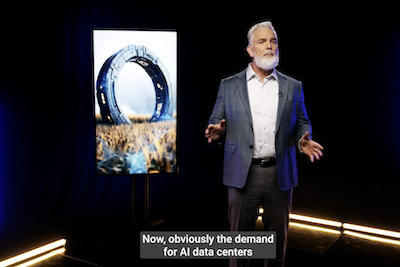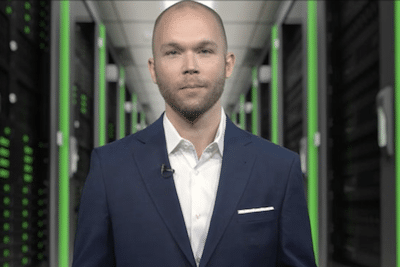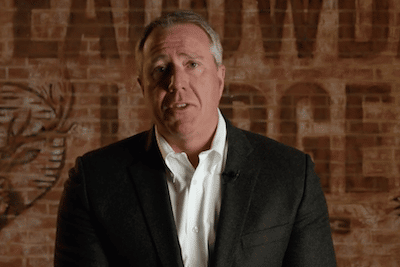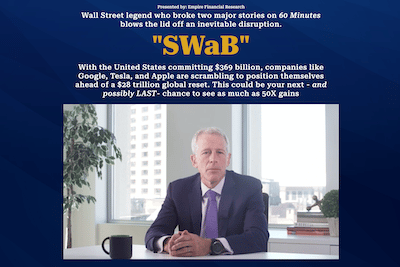Paul Mampilly’s latest stock teaser presentation centers around “iPower,” a trend that he says is “bigger than the market opportunity for Uber, Airbnb and Amazon combined.”
And according to Mampilly, there’s one “tiny” company at the forefront of it:
“One tiny California company holds the KEY that will ignite the projected $50 TRILLION new energy revolution … unleashing a bigger disruption than Amazon, Uber and Airbnb combined.”
Source: https://pro.banyanhill.com/p/WMC-PRLVPP-001/EPRLY513
What’s it all about?
In short, “iPower” is a word Paul Mampilly uses to describe the concept of a virtual power plant, a decentralized energy system where individuals can buy and sell power. And while he didn’t reveal his pick in the video, I figured it out by looking into his clues.
I also uncovered a second company he teased in the presentation. And in this post, I’ll show you everything I found. But first, let’s break down Mampilly’s prediction.
What Is iPower Technology?
The term “iPower” is one Paul Mampilly made up as part of his latest Banyan Hill Publishing stock teaser presentation, and he says it represents virtual power plants.
“When I say iPower, I’m talking about virtual power plants.”
What’s a virtual power plant?
A virtual power plant is a cloud-based distributed power plant that allows individuals with distributed energy resources (DERs) like solar to trade or sell energy.
For example, if you have a grid-connected home solar system that generates excess power, a virtual power plant can act as a software-based intermediary, allowing you to sell the excess energy to others on the network (and buy the energy you need).
So it’s basically a decentralized energy market where instead of having to deal with a centralized power company, you can buy and sell energy with others on the network.
Here’s how Paul Mampilly describes it:
“With this technology, I become the grid
I can sell power to my next-door neighbor.
Perhaps someone in another city or state.
I can even sell it to the power plants.
And earn income from a share of my spare solar power.
In short, my energy becomes a product I can sell as I see fit. Just like the power plants do.”
What’s the big deal?
Paul Mampilly discussed several potential benefits of “iPower,” including reducing dependence on fossil fuels and helping stabilize the grid.
But the main benefit he mentioned was that virtual power plants could potentially save millions of households money.
“Now, millions of households will have the chance to reap the same benefits … thanks to a sweeping rollout of iPower to the energy grid.
In time, it could give households an average savings of $6,000 each year.
This isn’t something that might happen.
It’s something that’s already mandated by a bipartisan government order — Federal Order 2222.”
As a quick side note, Federal Order 2222 is an order approved by the Federal Energy Regulatory Commission (FERC) in September 2020. And according to ferc.gov, it “will help usher in the electric grid of the future” and promote competition in electric markets.
In other words, the order helps make virtual power plants possible in the U.S.
Why does Mampilly suggest that “iPower” could help people save money?
From what I can gather, Mampilly’s belief that virtual power plants could make energy cheaper has to do with increased competition as more people begin selling their excess power. He also claims that solar power is the “absolute cheapest power possible” and that the software behind iPower technology can cut out “middlemen fees.”
“In short, my energy becomes a product I can sell as I see fit. Just like the power plants do.
Only they can NOT compete.
Again, solar is now the ‘cheapest electricity in history.’
So you’re getting the absolute cheapest power possible.
No middlemen fees.”
How does iPower work?
The basic idea behind the iPower (AKA virtual power plant) system Mampilly describes in the presentation is that software powered by AI, 5G, blockchain, and the Internet of Things (IoT) connects millions of small energy devices (known as DERs) to create a “new grid.”
“So how does iPower work exactly?
It starts with millions of small energy devices in the U.S. including:
2 million homes with solar panels…
67,000 wind turbines…
And 1.8 million EVs on the road.
Combined, they can generate enough power for nearly every American home … all for cheaper than fossil fuels.”
[…]
“So until now, there was no way to centrally manage ALL of these different energy devices — the same way a power plant does.
That’s where iPower comes in. Why it’s so transformational…”
[…]
“It’s like an orchestra — and iPower is the conductor.
So instead of one single power plant supplying a whole town, thousands of different power sources act as one.
And create a new grid that delivers the SAME amount of power, while cutting power bills to a thimble.”
And according to Paul Mampilly, it all works through an app that allows you to buy and sell energy, which he likens to using Airbnb, Uber, and Amazon.
“iPower potentially allows anyone like me, to sell my extra energy … just like I could sell the extra room in my house as an Airbnb, sell the use of my car through Uber and sell my products through Amazon.”
According to Paul Mampilly, it’s not just home solar systems that can be used to participate in the “new energy revolution” he describes; he says you can even use an electric car.
“Order 2222 just hit ‘fast forward’ on the new energy revolution.
In short, it allows YOU, me, any one of us to become a power plant…
With our home battery…
Our electric car…
Even our heating pump….
We can now potentially pool ANY of these power generators together, connect to the grid and start providing power — with the possibility of earning income in return.”
What’s he talking about?
What Mampilly is talking about here is vehicle-to-grid (V2G) technology, whereby technology is being developed that allows electric vehicles to send excess power back to the grid.
So instead of only being able to charge your EV, this tech allows you to discharge excess power from an EV battery, potentially earning money in the process.
This wasn’t the main focus of Mampilly’s pitch; it’s just another potential energy source he suggested could be sold using virtual power plant technology. But it’s an interesting concept nonetheless and reminded me of a presentation I wrote about featuring a different investment “guru” named Matt McCall (who pitched a V2G stock).
In any case, to sum it up… Mampilly said that iPower is the “third and final wave” of the energy revolution after “universal power creation” and energy storage. And he believes that one “iPower company” could become the “next trillion dollar giant.”
“And you’ll see why one iPower company has the potential to become…
The next TRILLION dollar giant
Replace centralized power plants…
And dominate the entire world’s entire power market, sparking a profit opportunity that could DWARF Uber, Airbnb and Amazon, which all went on to become market giants in under a decade.”
Mampilly didn’t reveal the name of this company in the presentation. And the only way to find out is to join his service, Profits Unlimited, which comes with a report called “iPower: The Tiny Company Launching a $50 Trillion Energy Disruption” that details his pick.
But I looked into the clues Mampilly shared in the presentation, and in the next section, I’ll show you what my research uncovered.
What iPower Company Is Paul Mampilly Teasing?
Given what Paul Mampilly said about “iPower” in the presentation, we know that the “iPower company” he’s teasing is in the virtual power plant space. And according to Mampilly, it manages “about 5 gigawatts of power” using “AI-powered software.”
“This iPower company manages more energy.
Five times more, to be exact.
Instead of a single coal plant…
This connects power generated from thousands of different sources…
Like wind turbines, batteries and solar panels…
And with the sum of its parts, creates a mega power plant of global size.
I’m talking about 5 gigawatts of power…
(The equivalent of five nuclear power plants!)
All run on AI-powered software.”
Paul Mampilly also shared clues relating to who’s working with the company, its customers, and where it has operations.
“Take Sunrun which actually has MORE solar and energy storage installations than Tesla.
It’s America’s biggest rooftop solar company.
And now it’s offering iPower to its customers … using this company’s software!
The same thing is true for dozens of its clients around the world … like the battery giant Sonnen which now operates Germany’s largest network of clean home energy with the help of this company’s software.”
[…]
“Recently this iPower company partnered with one of America’s biggest energy cooperatives…
One that services power to:
800 electric companies
700 phone utilities
And 50 million people in 48 states”
[…]
“Its iPower technology is already spreading on nearly four continents! It’s now supplying power to homes in…
France
Australia
Hong Kong
Belgium
Netherlands
India
JapanFifteen countries in total.”
[…]
“From clean energy titans like Tesla…
To tech titans like Amazon…
To Big Oil giants like Shell…
Everyone wants to use this company’s software.”
So, what’s his pick?
I believe the “iPower” company Paul Mampilly’s teasing is AutoGrid.
Why do I think that? Because for starters, the energy cooperative Paul Mampilly’s referring to appears to be the National Rural Telecommunications Cooperative (NRTC), and this article on cleantechnica.com shows that AutoGrid partnered with NRTC to “accelerate clean tech.”
AutoGrid also matches Paul Mampilly’s other clues.
For instance, the AutoGrid website shows that Amazon and Sonnen are partnered with the company and that Shell and Sunrun are customers.
And according to AutoGrid’s blog, the company manages “over 5,000 MW of VPPs across 15 countries,” which matches Mampilly’s “5 gigawatts of power” clue and the one about its global operations.
The only thing I wasn’t able to find is anything about Tesla using the company’s software. But if you look at what Mampilly said closely, he said that companies “like Tesla” want to use the software. He never specifically said that Tesla is using it.
Nevertheless, AutoGrid appears to be a match.
And the “software” Paul Mampilly talked about in the presentation lines up with AutoGrid’s Energy Internet Platform (EIP), which according to the company, helps “predict, optimize, and control” tens of thousands of DERs and millions of participants.
The company also describes the energy system it’s helping build as the “Energy Internet,” which is a very similar reference Mampilly made numerous times in the presentation.
How do you invest in Mampilly’s “iPower” pick?
As of writing, AutoGrid is NOT a public company, which is yet another thing that matches up with what Paul Mampilly said in the presentation. So it’s not possible to invest in it unless it goes public in the future. But Mampilly said he believes “that day is fast approaching.”
“This company has not started publicly trading YET…”
[…]
“That’s why I want you to know everything about this company, so you can get first dibs the moment this begins publicly trading…
And I strongly believe that day is fast approaching.
That’s why I want you to put this on your radar NOW…
So you’re ready to pull the trigger immediately, the moment I send the alert that its IPO day is here.”
It was a bit disappointing to learn that Mampilly’s pick isn’t even a public company, but that may change in the future if what he said is anything to go by. And he also mentioned a second company he’s interested in, which he refers to as an “ESAAS” company.
Recommended: Go here to see my #1 rated stock advisory of 2024
What’s Mampilly’s “ESAAS” Stock Pick?
Paul Mampilly teased a second company in the presentation that IS public.
In short, he says the company doesn’t make batteries but instead buys and operates them, and he refers to its business model as ESAAS or “energy storage as a service.”
“In the meantime, I have a stock you can buy into right away, the perfect complement to the iPower company I shared with you…
While the iPower company is democratizing energy, empowering everyday Americans to buy and sell their spare power…
This other energy stock is providing the Fortune 500, utilities and governments that same spare power — without the need to pay upfront for solar panels, batteries or anything like that.
I call this ESAAS.
That means ‘energy storage as a service.'”
According to Mampilly, its storage fleet can hold a gigawatt of energy, and for a monthly fee, the company provides access to “on demand” power.
“Right now, its storage fleet can hold an entire gigawatt.
Enough to power 700,000 American homes…”
[…]
“You simply pay a monthly fee…
And you get access to endless power — on demand — all available through its massive fleet of batteries.
No need to pay up front for the batteries. Or the solar panels.”
Mampilly also said that billionaire Peter Theil invested $15 million in the company:
“That’s why billionaire Peter Theil invested $15 million on the ground floor, dwarfing his initial stake in Facebook 30X over”
And lastly, he said you can “buy in today for less than $15.”
“Instead, they’re turning to this tiny company, giving it the lion’s share of this explosive energy market. It just went public. And you can buy in today for less than $15.”
What could it be?
Based on Paul Mampilly’s clues, the company he’s teasing is Stem, Inc. (STEM).
Stem, Inc. is a Fransisco-based company that, instead of making its own batteries, delivers and operates battery storage solutions for its customers. And the company developed an AI-powered software called Athena to help integrate and optimize energy resources.
What’s more, the clues about Peter Theil, how much energy its fleet can store, and the share price all line up with what Paul Mampilly said. So Stem looks like a match here.
And assuming I’m right, he’s not the only newsletter guru tracking this company. I only recently wrote about Adam O’Dell’s Infinite Energy presentation, which was a very similar pitch to Mampilly’s, and my research suggested that O’Dell’s pick was Stem.
As for whether or not Stem is a good investment, there are some helpful articles breaking down the investment case online, like this post on the Motley Fool website, for example.
So that might be a good place to start your research.
You could also check out Mampilly’s research report, “iPower: The Tiny Company Launching a $50 Trillion Energy Disruption,” as this covers both of the companies he talked about in the presentation (which I believe are AutoGrid and Stem).
The only “catch” is that you have to join Profits Unlimited to get that report. So let’s discuss what this service is about and what you get if you decide to try it out.
Should You Join Profits Unlimited?
Profits Unlimited is a stock advisory service run by Paul Mampilly of Banyan Hill Publishing focused on “mega trends” like artificial intelligence, the Internet of Things (IoT), blockchain, precision medicine, and energy companies like the ones we’ve discussed in this post.
Mampilly recommends a variety of small, medium, and large companies (in other words, companies with mixed market caps), but he says they all have one thing in common.
“In Profits Unlimited, I target innovative companies across multiple industries that I believe are set up for growth.
They vary in size and business, but they all have one thing in common — I believe they have massive potential to bring my readers incredible gains.”
Based on what Paul Mampilly said in the presentation, he has picked numerous winning stocks over the years as part of the Profits Unlimited service. And he says that, since launching the service in 2016, the total portfolio has “averaged 21% each year.”
“I launched Profits Unlimited in 2016. And since then, the total portfolio has averaged 21% each year.”
That doesn’t mean you’ll make money following Mampilly’s picks, but the service is legitimate and seems to have developed a decent track record over time.
What do you get if you join?
The main component of the Profits Unlimited service is the monthly newsletter issues where, each month, Paul Mampilly breaks down his latest recommendation and shares his research on the company so you can see why he’s recommending it.
You also get the “iPower” report I mentioned earlier, other research reports he’s created, weekly updates on his picks, and access to the model portfolio.
How much does it cost?
It does depend on where you join, but if you sign up for a subscription to Profits Unlimited through the presentation, it costs $47 for a year’s access.
Is Paul Mampilly the Real Deal?
Paul Mampilly is a former hedge fund manager with over 30 years of experience in finance. According to his Banyan Hill Publishing profile, Mampilly started his career in 1991 as a research assistant at Bankers Trust and has worked for other well-known banks.
Today, he runs a free newsletter and YouTube channel called Bold Profits Daily, as well as several paid services for Banyan Hill. His flagship service is Profits Unlimited, but Mampilly also runs half a dozen other, higher-tier services.
Most of his picks center around emerging tech trends, too. And I’ve uncovered some of these by looking into different presentations he’s released.
For example, I recently wrote about Paul Mampilly’s “12 Million Mile Battery” (nanopowder) recommendation and managed to uncover the company he was teasing. So you might find that post worthwhile if you want to see what other stocks he’s tracking.
In any case, while there’s no guarantee Paul Mampilly’s recommendations will make you money, and there are risks involved in following his ideas, he does seem to be a genuine expert based on everything I’ve seen.
Bottom Line
Paul Mampilly’s iPower presentation centers around virtual power plants.
To recap, Mampilly believes this tech could lead to the “democratization of energy” because we won’t have to rely on power from a single, centralized power company. And he suggests this could lead to cheaper energy and a significant opportunity for investors.
At the end of the day, nobody can predict what stocks will do well in the future, so it might pay to take the presentation with a pinch of salt. But it will be interesting to see how Mampill’s prediction unfolds, especially as more people utilize solar power and EVs.
What do you think? Is Mampilly’s pitch overhyped? Or is he onto something here? And do you think I’ve guessed his picks correctly? Let me know in the comments below.












Please note: By submitting a comment using the above comment form, you confirm that you agree with the storage and handling of your data by this site as detailed in our Privacy Policy.